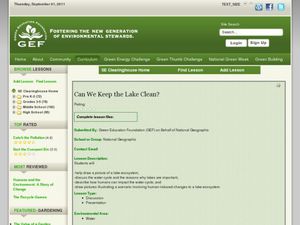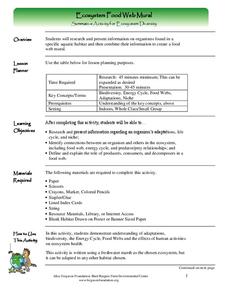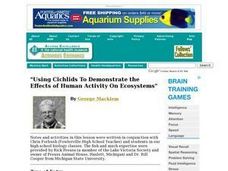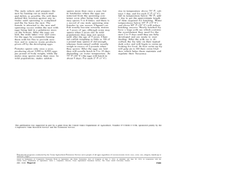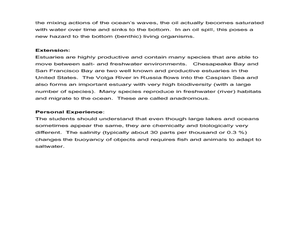Curated OER
Can We Keep the Lake Clean?
Learners are introduced to the water cycle. They help draw a picture of a lake ecosystem, adding human impacts that affect water quality. Students help fill in the components of a drawing of a water system. At the end of the...
Curated OER
Abundant Lakes
Students define lake life zones. They define stormwater runoff and its effects on lakes. They identify the relationship between decaying substances and water pollution. They construct a freshwater food web.
Curated OER
To Be Salty Sea Ice Or Not
Students explore what type of solutions freeze. They design their own experiments to compare how fresh water and salt water freezes. In addition, they write their observations in a journal and complete analysis questions.
Curated OER
Case of the Threespine Stickleback
Students examine why some freshwater populations of stickleback fish. In this macroevolution instructional activity students read a study packet then answer questions.
Curated OER
Water Cycle and Ecosystems
Young scholars explore the water cycle. In this investigative lesson, students examine the water cycle process. They will record their observations and discuss marine and freshwater ecosystems.
Curated OER
Ecosystem Food Web Mural
Learners create a food web mural about an ecosystem of the freshwater marsh. For this food web lesson plan, young scholars write about the organisms and how each one depends on another.
Earth Day Network
Conserving Water Through Art!
Having fresh, clean drinking water is a privilege many people take for granted. Help raise awareness about the scarcity of water and the importance of conservation by discussing different ways water is used in everyday life. Brainstorm...
Curated OER
Gravel Run - Freshwater Spring
Learners perform five lab experiments dealing with water run. Students monitor gravel run water quality. They conduct a bioassessment and collect information on water quality. Learners organize and analyze collected data.
Curated OER
Ecosystems
In this ecosystems worksheet, students complete a crossword puzzle with 35 questions about the different types of ecosystems and organisms in them.
Curated OER
"Using Cichlids To Demonstrate the Effects of Human Activity On Ecosystems"
Students explore the freshwater ecosystem of Africa's Lake Victoria by creating a freshwater aquarium. They investigate factors affecting the aquarium's ecosystem and conduct lab activities.
Curated OER
Eye On Conservation Drainage Basin
Middle schoolers are able to describe the importance of wetland vegetation. They describe the impacts human activities have on water systems. Students compare and contrast the effect of different soil types on water filtration.
Curated OER
It's Too Salty!
Students examine water shortage and the process of changing salt water to fresh water. They examine a world map, define key vocabulary terms, conduct experiments involving seeds and salt water and creating distilled water, and illustrate...
Curated OER
LD50 of NaCl to Gammarus spp.
Students learn the meaning of LD50 through lecture and discussion. Through experiment, students graph and calculate the LD50 of salt on fresh water amphipods. Students compare results of the experiment with pesticides and pollutants.
Curated OER
Animal Habitat Bar Graph
In this graphing activity, students examine a prepared bar graph and record which habitat their chosen animal lives in: desert, city, forest, ocean, prairie, or fresh water. There are no directions but it appears that a class could use...
Curated OER
Density: Floating, Sinking, and Suspending
Students observe teacher demonstrations that illustrate density. In this density lesson, the teacher demonstrates how air bubbles in a carbonated drink can cause a raisin to float and how an egg sinks in fresh water, but floats in salt...
Curated OER
Crawdad Grab
Students explore biology by conducting a freshwater fishing activity. In this crawdad activity, students discuss what a crawdad is, where they are found and how they can be prepared as a meal. Students utilize string, alligator clips,...
Curated OER
Wacky Water Critters
Students visit a local creek or stream. They collect water samples from the creek and observe and sort the "water critters" they find in the sample, observing smaller organisms under a microscope if necessary. They identify each organism...
Curated OER
"Our Lakes" Crossword
In this lakes worksheet, students complete a crossword puzzle by figuring out the vocabulary words associated with the 15 clues given.
Curated OER
Channel Catfish
Students study the life and biology of the Channel Catfish. In this aquatic biology lesson, students will examine the external and internal features of the catfish along with their breeding habits and environment. This lesson includes...
Curated OER
Water Water Everywhere and Not a Drop to Drink!
Middle schoolers describe limitations of fresh water resources on ships at sea. They realize the value of fresh water on the ocean and around the world. Students gain a knowledge of the process and economic cost of desalinization.
Curated OER
Oceanography
Second graders identify saltwater and freshwater habitats and the resources found in them. They compare and contrast the two habitats and discuss their findings. They discover the resources bodies of water can provide.
Curated OER
The Effect of Tides & Elevation on Wetland Plant Communities
Students comprehend how tides can impact shoreline plant communities through the study of a freshwater tidal marsh. They use actual tidal data to show that tidal ranges differ among geographic locations, even those relatively close...
Curated OER
Teacher's Guide For: Water Temperature and Salinity Experiment
Students experiment with water density, temperature and salinity. For this water lesson, students observe how the coldest water sinks to the bottom of a test tube, and how saltwater sinks in comparison to freshwater.
Curated OER
New Jersey Estuaries
Students experiment to discover that salt water is denser than fresh water by creating color coded solutions. They examine how heavy rainstorms and high tides develop layers of different degrees of density.


